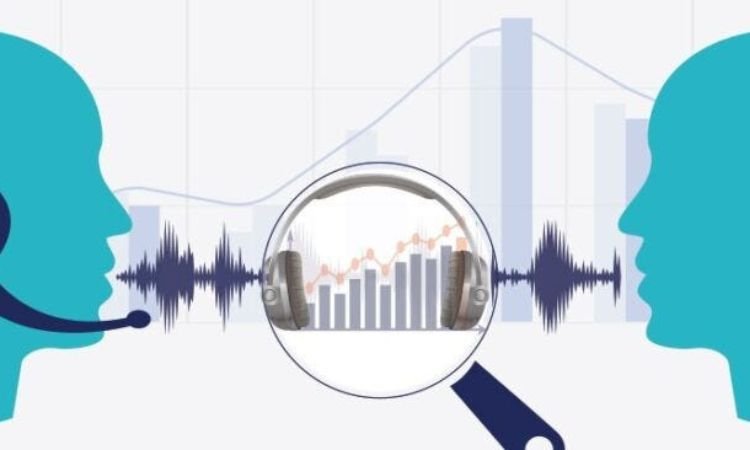Voice Analytics Market Size & Share

The global Voice Analytics Market Size has emerged as a significant and rapidly evolving sector within the broader realm of data analytics. With an impressive valuation of approximately USD 1131.84 million in 2023, this market is projected to experience substantial growth, reaching nearly USD 5839.98 million by 2032. The anticipated growth represents a robust compound annual growth rate (CAGR) of around 20% during the forecast period from 2024 to 2032. This expansion underscores the increasing adoption and integration of voice analytics technologies across various industries.
Key Benefits of Voice Analytics
Voice analytics technology leverages advanced algorithms and artificial intelligence to analyze and interpret voice data. This provides several key benefits, including:
- Enhanced Customer Experience: By analyzing customer interactions, businesses can gain insights into customer sentiment, preferences, and pain points, leading to improved service delivery and customer satisfaction.
- Operational Efficiency: Voice analytics helps in streamlining operations by automating routine tasks, reducing manual effort, and improving overall productivity.
- Real-Time Insights: The technology enables real-time monitoring and analysis, allowing organizations to make informed decisions quickly and respond to issues as they arise.
- Fraud Detection: Voice analytics can detect anomalies and suspicious behaviors, aiding in the identification and prevention of fraudulent activities.
- Improved Compliance: It assists in ensuring compliance with regulatory requirements by monitoring and analyzing communication patterns.
Key Industry Developments
Recent developments in the voice analytics market highlight its dynamic nature:
- Advancements in AI and Machine Learning: Innovations in artificial intelligence (AI) and machine learning (ML) are enhancing the accuracy and efficiency of voice analytics solutions.
- Integration with Other Technologies: Voice analytics is increasingly being integrated with other technologies such as natural language processing (NLP) and sentiment analysis to provide a more comprehensive understanding of voice data.
- Increased Adoption Across Sectors: Various industries, including healthcare, finance, and retail, are increasingly adopting voice analytics for its diverse applications.
Driving Factors
Several factors are contributing to the rapid growth of the voice analytics market:
- Rising Demand for Customer Experience Management: Organizations are increasingly focusing on enhancing customer experiences, driving the demand for voice analytics solutions that provide actionable insights into customer interactions.
- Growth in Voice-Activated Technologies: The proliferation of voice-activated devices and virtual assistants is creating a surge in voice data, necessitating advanced analytics solutions.
- Increased Focus on Data-Driven Decision Making: Businesses are prioritizing data-driven strategies, and voice analytics provides valuable data insights that support informed decision-making.
- Expansion of AI and ML Capabilities: Advances in AI and ML technologies are improving the accuracy and functionality of voice analytics tools.
COVID-19 Impact
The COVID-19 pandemic has had a mixed impact on the voice analytics market:
- Accelerated Digital Transformation: The pandemic accelerated the adoption of digital and remote solutions, including voice analytics, as businesses sought to enhance remote customer service and support.
- Challenges in Implementation: Disruptions in supply chains and resource availability during the pandemic posed challenges to the implementation and deployment of voice analytics solutions.
- Increased Demand for Customer Support Solutions: With the rise in remote interactions, there was an increased demand for solutions that could analyze and optimize customer support and interactions.
Restraining Factors
Despite its growth prospects, the voice analytics market faces several challenges:
- Data Privacy Concerns: Issues related to data privacy and security can hinder the adoption of voice analytics solutions, as organizations must ensure compliance with data protection regulations.
- High Implementation Costs: The initial investment and costs associated with implementing advanced voice analytics solutions can be a barrier for some organizations, particularly small and medium-sized enterprises.
- Complexity of Integration: Integrating voice analytics with existing systems and workflows can be complex and may require significant resources and expertise.
Market Segmentation
The voice analytics market can be segmented based on various factors:
- By Component:
- Solutions: Speech analytics, voice biometrics, and others.
- Services: Consulting, integration and deployment, and support and maintenance.
- By Deployment Mode:
- On-Premises
- Cloud-Based
- By Application:
- Customer Experience Management
- Fraud Detection
- Sales and Marketing
- Others
- By End-User Industry:
- Healthcare
- BFSI (Banking, Financial Services, and Insurance)
- Retail and E-Commerce
- Telecommunications and IT
- Others
Market Outlook
The voice analytics market is poised for significant growth, driven by technological advancements and increasing adoption across various sectors. The market’s positive outlook is supported by the growing need for enhanced customer experiences, operational efficiency, and data-driven decision-making. However, challenges such as data privacy concerns and high implementation costs must be addressed to sustain growth.
Market Trends
Several key trends are shaping the voice analytics market:
- Integration with AI and ML: Continued advancements in AI and ML are enhancing the capabilities of voice analytics solutions, making them more accurate and effective.
- Growing Adoption in Healthcare: The healthcare sector is increasingly adopting voice analytics for applications such as patient monitoring, diagnostics, and personalized care.
- Expansion of Cloud-Based Solutions: Cloud-based voice analytics solutions are gaining popularity due to their scalability, flexibility, and cost-effectiveness.
Industry Segmentation
The voice analytics industry is segmented based on components, deployment modes, applications, and end-user industries. This segmentation allows for a tailored approach to addressing the needs of different sectors and applications.
Regional Analysis/Insights
The voice analytics market exhibits varying trends across different regions:
- North America: The largest market share is held by North America, driven by technological advancements, high adoption rates of voice analytics solutions, and a strong presence of key market players.
- Europe: Europe is experiencing growth due to increasing investments in digital transformation and the adoption of voice analytics across various industries.
- Asia Pacific: The Asia Pacific region is expected to witness significant growth due to the rising demand for voice analytics in emerging markets and advancements in technology.
- Latin America: The market in Latin America is growing as businesses increasingly recognize the benefits of voice analytics for customer experience management.
- Middle East and Africa: The region is experiencing gradual growth, with increasing awareness and adoption of voice analytics solutions.
Major Key Players
Some of the major players in the voice analytics market include:
- NICE Ltd.
- Verint Systems Inc.
- CallMiner Inc.
- IBM Corporation
- Google LLC
- Amazon Web Services, Inc.
- Nuance Communications Inc.
- Speechmatics
- Cogito Corporation
- AudioCodes Ltd.
Opportunities
The voice analytics market offers several opportunities:
- Expansion in Emerging Markets: Growing economies in regions such as Asia Pacific and Latin America present opportunities for market expansion.
- Innovation in Technology: Continuous advancements in AI, ML, and NLP technologies provide opportunities for developing more sophisticated and effective voice analytics solutions.
- Increased Demand for Personalized Solutions: As businesses seek to offer personalized experiences, there is an opportunity to develop customized voice analytics solutions tailored to specific needs.
Challenges
The market faces several challenges, including:
- Data Privacy and Security: Ensuring compliance with data protection regulations and addressing privacy concerns are critical challenges for market players.
- Integration Complexity: The complexity of integrating voice analytics solutions with existing systems and workflows can be a barrier to adoption.
- High Costs: The cost of implementing advanced voice analytics solutions can be prohibitive for some organizations, particularly smaller businesses.
Scope
The scope of the voice analytics market encompasses various components, deployment modes, applications, and end-user industries. The market is characterized by rapid technological advancements, increasing adoption across sectors, and a growing focus on data-driven decision-making and customer experience management.




